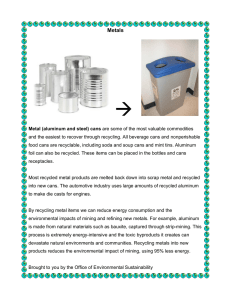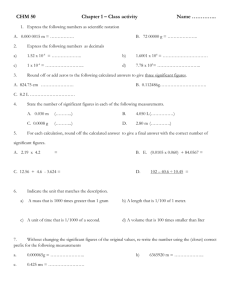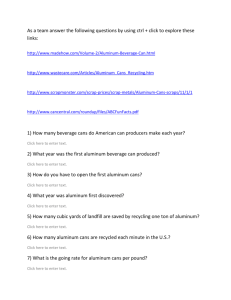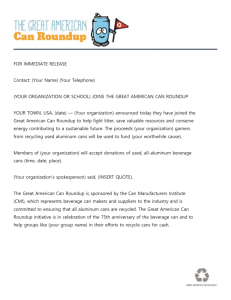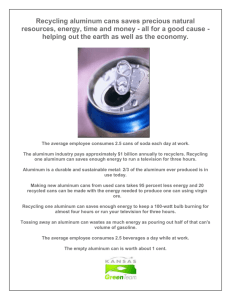M
advertisement
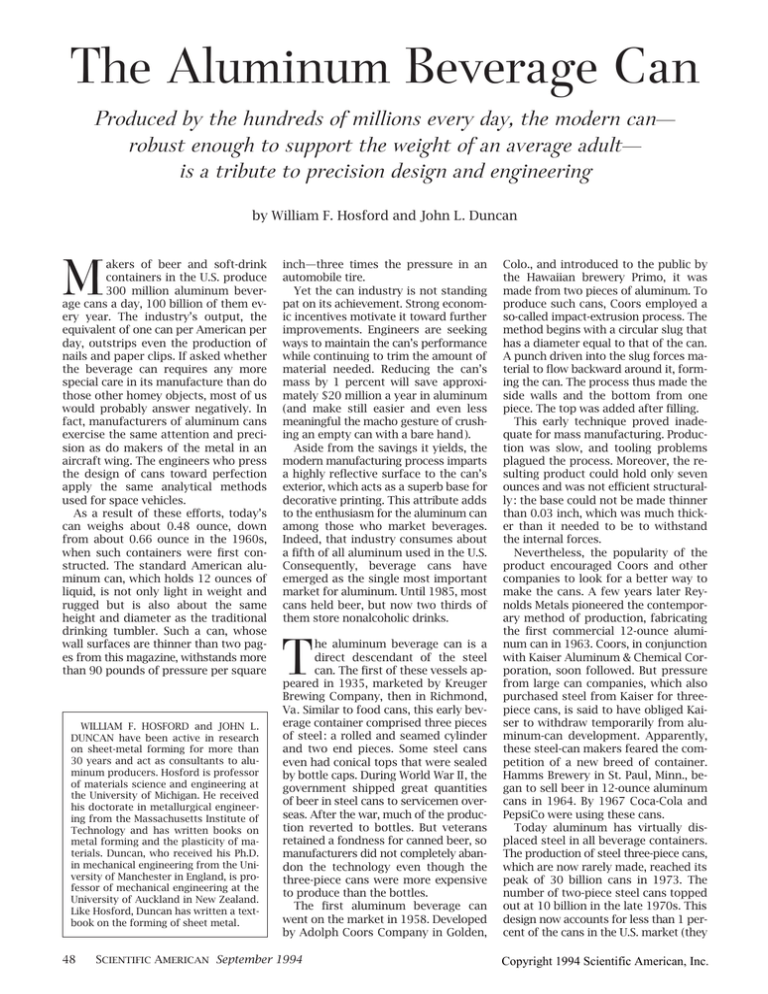
The Aluminum Beverage Can Produced by the hundreds of millions every day, the modern can— robust enough to support the weight of an average adult— is a tribute to precision design and engineering by William F. Hosford and John L. Duncan M akers of beer and soft-drink containers in the U.S. produce 300 million aluminum beverage cans a day, 100 billion of them every year. The industryÕs output, the equivalent of one can per American per day, outstrips even the production of nails and paper clips. If asked whether the beverage can requires any more special care in its manufacture than do those other homey objects, most of us would probably answer negatively. In fact, manufacturers of aluminum cans exercise the same attention and precision as do makers of the metal in an aircraft wing. The engineers who press the design of cans toward perfection apply the same analytical methods used for space vehicles. As a result of these eÝorts, todayÕs can weighs about 0.48 ounce, down from about 0.66 ounce in the 1960s, when such containers were Þrst constructed. The standard American aluminum can, which holds 12 ounces of liquid, is not only light in weight and rugged but is also about the same height and diameter as the traditional drinking tumbler. Such a can, whose wall surfaces are thinner than two pages from this magazine, withstands more than 90 pounds of pressure per square WILLIAM F. HOSFORD and JOHN L. DUNCAN have been active in research on sheet-metal forming for more than 30 years and act as consultants to aluminum producers. Hosford is professor of materials science and engineering at the University of Michigan. He received his doctorate in metallurgical engineering from the Massachusetts Institute of Technology and has written books on metal forming and the plasticity of materials. Duncan, who received his Ph.D. in mechanical engineering from the University of Manchester in England, is professor of mechanical engineering at the University of Auckland in New Zealand. Like Hosford, Duncan has written a textbook on the forming of sheet metal. 48 inchÑthree times the pressure in an automobile tire. Yet the can industry is not standing pat on its achievement. Strong economic incentives motivate it toward further improvements. Engineers are seeking ways to maintain the canÕs performance while continuing to trim the amount of material needed. Reducing the canÕs mass by 1 percent will save approximately $20 million a year in aluminum (and make still easier and even less meaningful the macho gesture of crushing an empty can with a bare hand ). Aside from the savings it yields, the modern manufacturing process imparts a highly reßective surface to the canÕs exterior, which acts as a superb base for decorative printing. This attribute adds to the enthusiasm for the aluminum can among those who market beverages. Indeed, that industry consumes about a Þfth of all aluminum used in the U.S. Consequently, beverage cans have emerged as the single most important market for aluminum. Until 1985, most cans held beer, but now two thirds of them store nonalcoholic drinks. T he aluminum beverage can is a direct descendant of the steel can. The Þrst of these vessels appeared in 1935, marketed by Kreuger Brewing Company, then in Richmond, Va. Similar to food cans, this early beverage container comprised three pieces of steel : a rolled and seamed cylinder and two end pieces. Some steel cans even had conical tops that were sealed by bottle caps. During World War II, the government shipped great quantities of beer in steel cans to servicemen overseas. After the war, much of the production reverted to bottles. But veterans retained a fondness for canned beer, so manufacturers did not completely abandon the technology even though the three-piece cans were more expensive to produce than the bottles. The Þrst aluminum beverage can went on the market in 1958. Developed by Adolph Coors Company in Golden, SCIENTIFIC AMERICAN September 1994 Colo., and introduced to the public by the Hawaiian brewery Primo, it was made from two pieces of aluminum. To produce such cans, Coors employed a so-called impact-extrusion process. The method begins with a circular slug that has a diameter equal to that of the can. A punch driven into the slug forces material to ßow backward around it, forming the can. The process thus made the side walls and the bottom from one piece. The top was added after Þlling. This early technique proved inadequate for mass manufacturing. Production was slow, and tooling problems plagued the process. Moreover, the resulting product could hold only seven ounces and was not eÛcient structurally : the base could not be made thinner than 0.03 inch, which was much thicker than it needed to be to withstand the internal forces. Nevertheless, the popularity of the product encouraged Coors and other companies to look for a better way to make the cans. A few years later Reynolds Metals pioneered the contemporary method of production, fabricating the Þrst commercial 12-ounce aluminum can in 1963. Coors, in conjunction with Kaiser Aluminum & Chemical Corporation, soon followed. But pressure from large can companies, which also purchased steel from Kaiser for threepiece cans, is said to have obliged Kaiser to withdraw temporarily from aluminum-can development. Apparently, these steel-can makers feared the competition of a new breed of container. Hamms Brewery in St. Paul, Minn., began to sell beer in 12-ounce aluminum cans in 1964. By 1967 Coca-Cola and PepsiCo were using these cans. Today aluminum has virtually displaced steel in all beverage containers. The production of steel three-piece cans, which are now rarely made, reached its peak of 30 billion cans in 1973. The number of two-piece steel cans topped out at 10 billion in the late 1970s. This design now accounts for less than 1 percent of the cans in the U.S. market (they Copyright 1994 Scientific American, Inc. RIVET Used to secure the tab to the can, this integral piece of the lid is made by stretching the center of the lid upward slightly. It is then drawn to form a rivet. NECK The body of the can is narrowed here to accommodate the smaller lid. TAB This separate piece of metal is held in place by the integral rivet. LID The lid may make up 25 percent of the total weight. It consists of an alloy that contains less manganese but more magnesium than the body does, making it stronger. To save on the mass, manufacturers make the diameter of the lid smaller than that of the body. 05” 0.0 FLANGE After the top of the can is trimmed, it is bent and seamed to secure the lid after filling. SCORED OPENING The lid is scored so that the metal piece pushes in easily without detaching. BODY This aluminum alloy typically incorporates by weight 1 percent magnesium, 1 percent manganese, 0.4 percent iron, 0.2 percent silicon and 0.15 percent copper. It is ironed to dimensions within 0.0001 inch and is made thicker at the bottom for added integrity. It withstands an internal pressure of 90 pounds per square inch and can support 250 pounds. 0.003” LABEL The ironing process that thins the body of the can produces a highly reflective surface suitable for decoration. The mirrorlike finish may be one of the main reasons marketers of beverages adopted the aluminum can. 0.006” 0.012” BASE The bottom of the can assumes a dome shape in order to resist the internal pressure. ANATOMY OF MODERN BEVERAGE CAN reveals the dimensions that design and engineering must achieve on a daily basis. The goal of can makers is to reduce the amount of alu- Copyright 1994 Scientific American, Inc. minum needed without sacriÞcing structural integrity. A can now weighs about 0.48 ounce; the industry hopes to reduce that weight by about 20 percent. SCIENTIFIC AMERICAN September 1994 49 BLANK AND DRAW FROM SHEET REDRAW STEPS IN CAN MANUFACTURE begin with an aluminum alloy sheet. Blanks 5.5 inches in diameter are cut from the sheet; a punch draws the circle to form a 3.5-inch-diameter cup. A are, however, more popular in Europe). The process that Reynolds initiated is known as two-piece drawing and wall ironing. Aluminum producers begin with a molten alloy, composed mostly of aluminum but also containing small amounts of magnesium, manganese, iron, silicon and copper. The alloy is cast into ingots. Rolling mills then ßatten the alloy into sheets. The Þrst step in can making is cutting circular blanks, 5.5 inches in diameter. Obviously, cutting circles from a sheet produces scrap. The theoretical loss for close-packed circles is 9 percent; in practice, the loss amounts to 12 to 14 percent. To reduce this waste, sheets are made wide enough to incorporate 14 cups laid out in two staggered rows. Each blank is drawn into a 3.5-inch-diameter cup. The next three forming operations for the can body are done in one continuous punch stroke by a second machineÑin about one Þfth of a second. First, the cup is redrawn to a Þnal inside diameter of about 2.6 inches, which increases the height from 1.3 to 2.25 inches. Then, a sequence of three ironing operations thins and stretches the walls, so that the body reaches a height of about Þve inches. In the last step, the punch presses the base of the can body against a metal dome, giving the bottom of the can its inward bulge. This curve behaves like the arch of a bridge in that it helps to prevent the bottom from bulging out under pressure. For added integrity, the base of the can and the bottom of the side walls are made thicker than any other part of the can body. Because the alloy does not have the same properties in all directions, the can body emerges from the forming op50 IRON AND DOME TRIM EARS CLEAN second machine then redraws the blank, irons the walls and gives the base its domeÑall in approximately one Þfth of a second. These procedures give the can wall its Þnal dimen- erations with walls whose top edges are wavy, or Òeared.Ó To ensure a ßat top, machinery must trim about a quarter inch from the top. After trimming, the cup goes through a number of highspeed operations, including washing, printing and lacquering. Finally, the can is automatically checked for cracks and pinholes. Typically, about one can in 50,000 is defective. Ironing is perhaps the most critical operation in making the body of the can. The precisely dimensioned punch holds and pushes the cup through two or three carbide ironing rings. To thin and elongate the can, the punch must move faster than the metal does in the ironing zone. The clearance between the punch and each ring is less than the thickness of the metal. The friction generated at the punch surface assists in pushing the metal through the ironing rings. To increase this friction, the punch may be slightly roughened with a criss-cross scratch pattern (which can be seen, impressed on the inside of a can). On the exterior of the can the shearing of the surface against the ironing rings yields the desired mirror Þnish. The side walls can be thinned without loss of integrity because, structurally, the can is a Òpressure vessel.Ó That is, it relies for part of its strength on the internal force exerted by carbon dioxide in beer and soft drinks or by the nitrogen that is now infused into such uncarbonated liquids as fruit juice. Indeed, most beers are pasteurized in the can, a process that exerts nearly 90 pounds per square inch on the material. Carbonated beverages in hot weather may also build up a similar pressure. Filling introduces a diÝerent kind of stress on the can. During this stage, the can (without its lid ) is pressed tightly against a seat in a Þlling machine. It must not buckle, either during Þlling and sealing or when Þlled cans are stacked one on another. Hence, can makers specify a minimum Òcolumn strengthÓ of ,,, , ,,, ,, ,,, ,, ,,,, ,,, ,, 1 2 PUNCH SLEEVE ALUMINUM BLANK DRAWING AND IRONING constitute the modern method of beverage can manufacture. The initial draw transforms the blank into a small cup (1 ). The cup is trans- SCIENTIFIC AMERICAN September 1994 Copyright 1994 Scientific American, Inc. their dimensions fall out of speciÞcation, which occurs sometimes more than once a day. M DECORATE NECK FLANGE FILL AND SEAM sions. After the ÒearsÓ at the top of the walls are trimmed, the can is cleaned, decorated and then ÒneckedÓ to accommodate the smaller lid. The top is ßanged to secure the lid. Once Þlled and seamed shut, the can is ready for sale. about 250 pounds for an empty can body. Thin-walled structures do not easily meet such a requirement. The slightest eccentricity of the loadÑeven a dent in the can wallÑcauses a catastrophic collapse. This crushing can be demonstrated by standing (carefully) on an upright, empty can. Manufacturers avoid failures by using machines that hold the cans precisely. The second piece of the can, the lid, must be stiÝer than the body. That is because its ßat geometry is inherently less robust than a curved shape (dams, for instance, bow inward, presenting a convex surface to the waters they restrain). Can makers strengthen the lid by constructing it from an alloy that has less manganese and more magnesium than that of the body. They also make the lid thicker than the walls. Indeed, the lid constitutes about one fourth the total weight of the can. To save on the mass, can makers decrease the diameter of the lid so that it is smaller than the diameter of the cylinder. Then they Òneck downÓ the top part of the cylindrical wall, from 2.6 to 2.1 inches, to accommodate the lid. An ingenious integral rivet connects the tab to the lid. The lid is scored so that the can opens easily, but the piece of metal that is pushed in remains connected. In addition to clever design, making billions of cans a year demands reliable production machinery. It has been said that in order to prove himself, an apprentice Swiss watchmaker was not required to make a watch but rather to make the tools to do so. That sentiment applies to can manufacturing. As one production manager remarked, ÒIf at the end of a bad day, you are a half million cans short, someone is sure to notice.Ó A contemporary set of ironing dies can produce 250,000 cans before they require regrinding. That quantity is equivalent to more than 20 miles of aluminum stretched to tolerances of 0.0001 inch. Die rings are replaced as soon as 3 IRONING RING ferred to a second punch, which redraws the can; the sleeve holds the can in place to prevent wrinkling (2 ). The punch Copyright 1994 Scientific American, Inc. CAN WALL uch of the success behind the consistent and precise production lies in the strong yet formable alloy sheet. The metallurgical properties responsible for the performance of modern can sheet have been proprietary and therefore not well known. Only within the past decade has that situation changed. Through the eÝorts of Harish D. Merchant of Gould Electronics in Eastlake, Ohio, James G. Morris of the University of Kentucky and others, scientiÞc papers on the metallurgy of can sheet have become more widely published. We now know that three basic factors increase the strength of aluminum. We have already mentioned one of them: manganese and magnesium dissolved into the material. These atoms displace some of the aluminum ones in the substance. Because they are slightly diÝerent in size, the manganese and magnesium atoms distort the crystal lattice. The distortions resist deformation, thus adding strength to the sheet. The second contribution comes from the presence of so-called intermetallic particles. Such particles, which form during the processing of the sheet, consist of a combination of diÝerent metals in the alloy (mostly iron and manganese). They tend to be harder than the alloy itself, thus supplying strength. Perhaps the most important contribution to sheet strength, however, is the work hardening that occurs when the sheets are cold-rolled (ßattened at room temperature). During this shaping, dislocations, or imperfections, in the lattice materialize. As the metal deforms, the dislocations move about and increase in number. Eventually they become entangled with one another, making further deformation more diÛcult. 4 ,,, ,,, pushes the can past ironing rings, which thin the walls (3 ). Finally, the bottom is shaped against a metal dome (4 ). SCIENTIFIC AMERICAN September 1994 51 Unfortunately, this work hardening dramatically reduces the ability of the material to stretch. Tensile tests indicate that the elongation capacity drops from 30 percent to about 2 or 3 percent. Conventional wisdom had it that sheets can be formed only if the material has a high tensile elongation. Certainly in the automotive industry, body parts are formed from fully annealed sheets that can elongate more than 40 percent. This philosophy guided the early attempts to make two-piece aluminum cans. Researchers concentrated on annealed or partially work-hardened sheets, which sacriÞced strength for ductility. The understanding of formability received a major boost from studies in the 1960s by Stuart P. Keeler and Walter A. Backofen of the Massachusetts Institute of Technology and Zdzislaw Marciniak of the Technical University in Warsaw, among others. Looking at the behavior of various sheet metals, they considered more than just the behavior under tension applied in one direction (as is done in the tension test). They also looked at what happens when tension is applied simultaneously in two directions. They showed that a small window of strains exists that permits forming without structural failure. Although work hardening greatly reduces the size of this window, a small slit nonetheless remains openÑenough to permit the doming of the base and drawing and redrawing of the side walls. The crucial advance that made the aluminum can economical, however, came from Linton D. Bylund of Reynolds. He realized that cans could be made from a fully work-hardened sheet using a carefully designed process that speciÞed the placement of the ironing rings, the shape of the punch and dies, and many other parameters. The strong, fully work-hardened sheet made it possible to use sheet that was thinner, saving enough weight to make the cans economically competitive. Nowhere is the technique of forming work-hardened sheet more apparent than it is in the cleverly designed rivet that holds the tab on the can lid. The rivet is an integral piece of the lid. To make it, the center of the lid must be stretched by bulging it upward a bit. This ÒextraÓ material is drawn to form a rivet and then ßattened to secure the tab (which is a separate piece of metal). B ANNUAL BEVERAGE CAN PRODUCTION in the U.S. has increased by several billion over the past few years. The two-piece aluminum can overwhelmingly dominates the market; steel cans constitute less than 1 percent. Three-piece steel cans, which are now rarely made, reached their peak production in the mid-1970s. esides making the can sheet stronger, manufacturers also sought to reduce the amount of aluminum needed by controlling the waviness, or earing, which as we have seen takes place at the top of the can after ironing. The eÝect derives from the crystallographic texture of the aluminum sheet, that is, the orientation of its crystal structure. Hence, earing is inevitable to some extent. Hans-Joachim Bunge of the Technical University in Clausthal, Germany, and Ryong-Joon Roe of Du Pont and others have developed x-ray diÝraction techniques to describe qualitatively the textures that cause earing. Laboratory technicians prepare specimens by grinding away layers of the sheet to expose material at diÝerent depths. X-ray diÝraction coupled with elegant analytical techniques automatically produces threedimensional diagrams that reveal the preferred orientation of crystals as a function of depth in the sheet. Such diagnostic approaches have enabled aluminum companies to produce sheet that yields much smaller ears. Metallurgists balance the two predominant crystallographic textures that exist in the aluminum. One kind of texture arises during annealing of the alloy after the alloy is hot-rolled from ingots. It causes four ears to appear every 90 degrees (at 0, 90, 180 and 270 degrees) around the circumference of the can. The second kind of texture results from cold-rolling the sheet, which produces an ear at 45, 135, 225 and 315 degrees. Proper control of annealing and rolling can lead to a combination of the two textures such that ears caused by one Þll the valleys caused by the other. The result is eight very low ears. The maximum height of an ear is often less than 1 percent of the height of the cup. Consistent processing of metal and careful design have now made each part of the can about as strong as any other. It is not unusual to Þnd cans in which the opening on the lid fractures, and the bottom dome and lid bulge at nearly the same pressure, within the range of 100 to 115 pounds per square inch. Despite the success of current design and manufacture, can makers are still searching for reÞnements. Much of the investigation focuses on ways to use aluminum more eÛciently, because the metal represents half the cost of the can. One possibility for saving would be to cast the molten alloy into thin slabs rather than into thick ingots, as is currently done. A typical ingot may be 30 inches thick, which is rolled down 52 Copyright 1994 Scientific American, Inc. NUMBER OF CANS PRODUCED IN THE U.S. (BILLIONS) 100 TOTAL BEVERAGE CANS 80 THREE-PIECE CAN 60 TWO-PIECE CAN TWO-PIECE ALUMINUM 40 THREE-PIECE STEEL 20 TWO-PIECE STEEL 0 1965 1970 1975 SCIENTIFIC AMERICAN September 1994 1980 1985 1990 by a factor of 2,500 to 0.011 or 0.012 inch. So much rolling requires expensive capital equipmentÑfurnaces and rolling millsÑand consumes a lot of energy. It is possible to cast aluminum continuously into slabs that are an inch thick or less. These thin slabs would require much less rolling to reach the desired Þnal sheet thickness. Continuous casting is used for some soft aluminum alloysÑfor example, aluminum foil is made from material cast to a thickness of 0.1 inch. Unfortunately, production of satisfactory can stock from thin slabs thwarts the metallurgists. The faster cooling and decreased rolling inherent in continuous casting do not yield the desired metallurgical structure. Two main problems arise. First, crystallographic texture cannot be properly controlled to prevent large ears. Second, the faster cooling rate produces severe diÛculties in ironing the can walls. These ironing problems develop because of the nature of the intermetallic particles that form when the molten alloy solidiÞes. Intermetallic particles that develop during solidiÞcation are much larger than those that originate during processing (which as we have seen impart strength to the sheet). Because of their size, they play a key role in ironing. During this procedure, aluminum tends to adhere to the ironing rings. Ordinarily, the intermetallic particles, which are about Þve microns in size, act like very Þne sandpaper and polish the ironing rings. The faster cooling rates of continuous casting, however, produce intermetallic particles that are much smaller (about one micron). At this size, the particles are not very effective in removing aluminum that sticks to the ironing rings. As a result, aluminum builds up on the rings and eventually causes unsightly scoring on the can walls. The problem of achieving thin slabs with the desired intermetallic particles may yet be solved, perhaps by altering the composition of the alloy or by shifting the rate of solidiÞcation from the materialÕs molten state. T he control of casting epitomizes a recurrent feature of the whole can story : one behavior is carefully traded oÝ against another, from the control of earing and ironability to economical sheet production, from can weight to structural integrity. Yet one cost element eludes an easy balance: the energy needed to make cans. Most of this outlay lies in the aluminum itself. Taking into account ineÛciencies in electricity distribution and smelting, industry experts estimate that 2.3 megajoules of energy is needed to produce Copyright 1994 Scientific American, Inc. EASY-OPENING LIDS were introduced on three-piece steel cans in 1961. The original caption reads: ÒHousewives of ancient Greece and the space age compare containers for the kitchen at the press debut of the new canning innovation by the Can-Top Machinery Corp., Bala-Cynwyd, Pa.Ó the aluminum in one can. This value is equal to about the amount of energy expended to keep a 100-watt bulb lit for six hours, or about 1.7 percent of the energy of a gallon of gasoline. Although small, it represents the major expenditure of a can. One way to reduce this expense is through recycling, which can save up to 95 percent of the energy cost. Indeed, more than 63 percent of aluminum cans are now returned for remelting. Recycling also has an important part within the aluminum mill. For every ton of can bodies made, a ton of scrap metal is produced. This scrap is remelted and thus injected back into the manufacturing cycle. Developing simpler ways of producing can sheet and Þnding stronger materials that can lead to lighter cans should save more money and energy. Meeting these goals presents a great challenge. Existing cans already use a highly strengthened, well-controlled sheet. Their shape is Þnely engineered for structural strength and minimum weight. And with little tool wear, the production machinery in a single plant is capable of making many millions of cans a day with few defects. The re- wards of even small improvements, however, are quite substantial. The demand for aluminum beverage cans continues to grow everywhere in the world; their production increases by several billion every year. The success of the can is an industrial lesson about what can be achieved when scientiÞc and engineering skills are combined with human perseverance. FURTHER READING A GOLDEN RESOURCE. Harold Sohn and Karen Kreig Clark. Ball Corporation, 1987. FROM MONOPOLY TO COMPETITION: THE TRANSFORMATIONS OF ALCOA, 1888Ð 1986. George David Smith. Cambridge University Press, 1988. THE MECHANICS OF SHEET METAL FORMING. Z. Marciniak and J. L. Duncan. Edward Arnold, 1992. ALUMINUM ALLOYS FOR PACKAGING. Edited by J. G. Morris, H. D. Merchant, E. J. Westerman and P. L. Morris. Minerals, Metals and Materials Society, Warrendale, Pa., 1993. METAL FORMING: MECHANICS AND METALLURGY. William F. Hosford and Robert M. Caddell. Prentice Hall, 1993. SCIENTIFIC AMERICAN September 1994 53

